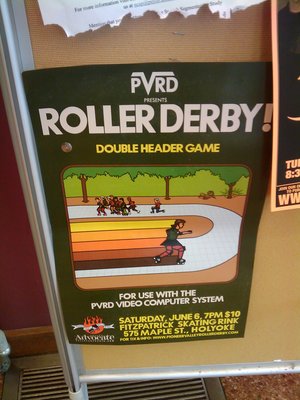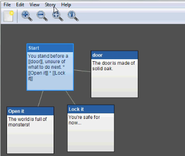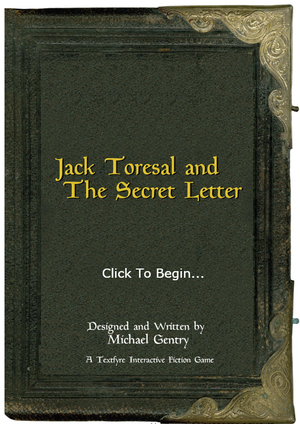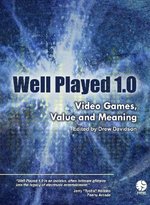I’ve been meaning to write something deliberate and detailed about the May 3 Penguicon talk, “Rule-Based Programming in Interactive Fiction,” by Andrew Plotkin (a.k.a. Zarf). And I’m still waiting to do that. I didn’t want to wait any longer to mention the talk on here, though, since it is presented very well in its Web version and will be useful for many people. It’s an intriguing discussion of the other major idea behind Inform 7 – the one that isn’t “natural language” programming. The discussion of how to code interactive fiction is one I’ve been mulling over as I continue to work on Curveship. I think providing first-class representations of actions is very helpful in dealing with some of the problems Zarf addresses, although it doesn’t solve everything by itself. And I think that having representations, within actions, of atomic events (such as exerting force on something and thereby touching it) deals with another of the problems that Zarf mentioned. But I’ll have to leave the extended discussion of that for another post.
Computational Creativity at ICCC-X
The First International Conference on Computational Creativity will be taking place in Portugal on January 7-9 2010. ICCC-X will follow on a decade of smaller-scale workshops and symposia. The call for papers lists the deadline of September 26 (extended 5 days) for papers, and promises:
The conference will include traditional paper presentations, will showcase the application of computational creativity to the sciences, creative industries and arts, and will incorporate a “show and tell” session, which will be devoted to demonstrations of computational systems exhibiting behaviour which would be deemed creative in humans.
Note also that contributions are solicited in several areas, including “specific applications to music, language and the arts, to architecture and design, to scientific discovery, to education and to entertainment.”
Twine is Rolled Out
Chris Klimas, the hypertext and IF author who runs Gimcrack’d, has just released free versions of Twine for Mac and Windows, along with documentation and several screencasts that explain how the system works and a command-line tool, called “twee,” for working with stories in Twine’s format. Twine is a system for constructing interactive stories using a visual map, not unlike Eastgate Systems’ Storyspace. While it lacks the august heritage of that piece of software, Twine is freely available and free to use for any purpose, even commercially.
When Twine build a story for publication or for the author’s examination, it does this in HTML/CSS. That means that readers won’t need any special software to explore stories written in Twine. Lots of text formatting can be done without getting into HTML and CSS, although authors are welcome to get into it as deeply as they like. The system supports some sophisticated presentation capabilities, including a stretchtext mode. It’s not quite a guard field, but the “choice” macro locks off certain options when others have been taken. Under the hood of Twine is TiddlyWiki, a personal Wiki took for the Web. This handy personal notebook system has been reshaped for interactive narrative rather than productivity, though, and pretty thoughtfully.
Having just started up Twine and fiddled with it a bit, I’m impressed at how easy it is to use, even if one doesn’t read the documentation or watch the screencasts first. It seemed at first that there would be no way link two different occurrences of a word to two different texts, but after a quick bit of reading I was able to figure out how to change [[word]] to [[word|word2]] in one place and give one of the links a different internal name. I’m looking forward to using Twine (and probably twee) further. It could be useful for doing a small project – perhaps a collaboration? – and it might work well as an option for students, too.
Jack Toresal and The Secret Letter Released
Michael Gentry, author of the stunning, large-scale, Lovecraftian interactive fiction Anchorhead, has another full-scale IF, his first since that award-winning game came out in 1998.
Dave Cornelson, who founded the Speed IF competitions and the IFWiki, has led his interactive fiction company, Textfyre, to publish its first game.
The game that is so notable in both of these ways is Jack Toresal and The Secret Letter. It is available for either Windows or Mac for about $25. As with all of the planned offerings of Textfyre, this game is directed at a specific audience: young readers wanting to experience the pleasures of reading while playing computer games. The hope, no doubt, is that parents will appreciate the fun and literacy-enhancing qualities of interactive fiction.
You can check out the game online: There is an in-browser demo that runs using Microsoft Silverlight. (The game itself was developed in Inform 7, and was programmed by Graeme Jefferis, not Gentry.) The interface offers a book-like framework for the IF session and allows the player to flip ahead to a map or back to previous sections of the transcript. The illustrations were done by Erika Swanson. You can read more about the development of the game and the progress of the company on The Textfyre Times, Dave Cornelson’s blog.
The setting and the situation at the beginning of Jack Toresal is quite compelling, and after only a bit of interaction, I could see already that there are some interesting twists (including gender play), lots to explore, and a variety of people to meet and conversations to have. (I’ve played the game just a bit on my own; I was glad to also get to play and discuss the game with the Boston IF group yesterday.) Gentry’s writing is appropriate to the game’s audience, and is also effective and lively. Although this game probably lacks the tentacle attacks and generations of incest that made Anchorhead so chilling, it doesn’t pull punches for the kiddies – you can get Jack very unpleasantly killed if you don’t lead him to outwit his opponents.
Since Cascade Mountain Publishing ceased its run in 2000, I haven’t heard of a commercial IF company or publisher that has completed a project and released a game. Yes, there have been people selling their own IF in various forms – I’ve been one of them, with my hardback edition of Winchester’s Nightmare; Peter Nepstad has also sold his 1893: A World’s Fair Mystery. But Textfyre seems remarkable in accomplishing the commercial development and publication of a piece of interactive fiction that otherwise wouldn’t have been written, in putting together projects that involve many people. The company has wisely focused on a particular market, and on a particular type of reader/player that is not well-served by existing IF. Textfyre used a new development model in which programming is separated from writing and design, which themselves are potentially separated. (Gentry did both in this first title, but that won’t particularly be the case in others.) This first result, even though it is for younger readers, seems to be a good use of a major talent. Even to us older readers, it could be as interesting as a major release from an independent author. I’ll look forward to playing Jack Toresal and The Secret Letter further, and will hope that this release will just be an auspicious beginning for Textfyre.
The Underdogs Have a Home
Famous abandonware site Home of the Underdogs is back, or at least quickly returning to its earlier state, at http://www.hotud.org/. Different appearance, same games, same mission and community.
Update, June 22: HotU is being revived on several sites, as Clara noted in comments: http://www.homeoftheunderdogs.net and http://hotu.pratyeka.org are others.
A Machine to Play Pitfall
Carlos Diuk, Andre Cohen, and Michael L. Littman of Littman’s RL3 Laboratory at Rutgers devised a new way of doing reinforcement learning, using Object-Oriented Markov Decision Processes, a representation that looks at a higher level than usual and considers objects and interactions. They had a paper about this at last year’s International Conference on Machine Learning (ICML). Better yet, they demonstrated their OO-MDPs representation by using it in a system that learned to play Pitfall in an emulator. I don’t believe that the system got all the treasures, but watching it play and explore the environment was certainly impressive. It seems like the technique is an interesting advance. By trying it out on a classic game, the researchers suggest that it will have plenty of “serious” uses in addition to being used in video game testing and in game AI.
The Vision’s Still Active

Playing the Irish Game, Talking About Train

I got to hear Brenda Brathwaite speak about her recent work yesterday. As you know if you’re read the Escapist article about her board games, she’s been developing a series of non-digital games about very serious subjects: The middle passage, Cromwell’s invasion of Ireland, and the Holocaust – so far. I also got to talk with her and some others about Train (upper right) at the GAMBIT Game Lab and got to play against her there in Siochan Leat (lower left). The latter, also known as “The Irish Game,” is a very playable game, although in my limited experience, it seems like it may have too many symmetries. I tried to play for a draw (since that seemed like a “fair” outcome), forgot about a rule and fell behind, and then caught up again to draw the game in the end. Since Train was “spoiled” for me and others, we talked about the play that had taken place in other sessions, and ended up having a very interesting discussion. I have no problem with games that rely on the players being naive, and which can be played only once, as long as that one experience is valuable. The verbal game Max and Nora is like this, and the way that some people play the party game Psychiatrist is similar, also. The latter game can easily be generalized, though, and can be endless fun (and insightful) if it is. Train is about something quite different: the drive for efficiency that obscures the ethics of one’s action. It is meant to provoke substantial conversation, and it does that well, helping us think about the nature of play and the design of games as well as about an important historical episode.

These games impressed me as very thoroughly thought through on a material as well as a formal level. They also impressed me as original, unique art works, a quality which in some ways contributes to their ability to tackle difficult subjects. I do think that it works against their purpose in some ways, though. Many more people could play and benefit from these games if they were cheap or “open,” rather than unique. Still, I can’t complain about the project, and I’ll look forward to the next games in Brathwaite’s series.
“Platforms” and Positioning
Tarleton Gillespie, author of Wired Shut: Copyright and the Shape of Digital Culture, presented an interesting paper at MIT’s Media in Transition 6 conference – one that is helpfully available online, and which is called “The Politics of ‘Platforms.'”
Gillespie considers the way that YouTube and other companies in the business of “content hosting” have positioned themselves as offering “platforms” – a stance that has populist benefits and which at least has the potential to distance these companies from liability for material they serve up. Interestingly, Gillespie finds that the computational sense of platform pre-dates this Web 2.0 and content-delivery sense. Admittedly, that sense, too, is a relatively new way of thinking about platform, and the most recent OED sense. Gillespie quotes this fine blog post by Marc Andreessen:
The key term in the definition of platform is “programmed”. If you can program it, then it’s a platform. If you can’t, then it’s not.
So, if you’re thinking about computing on the Internet, whenever anyone uses the word “platform”, ask: “Can it be programmed?” Specifically, with software code provided by the user? If not, it’s not a platform, and you can safely ignore whoever’s talking — which means you can safely ignore 80%+ of the people in the world today who are using the term “platform” and don’t know what it means.
This, by the way, is essentially sense of platform that the Platform Studies book series aims to investigate, although we don’t advocate that people ignore Google, YouTube, and so on.
The focus of the series is on computational platforms not because Ian and I disdain other uses of the word “platform” – we certainly don’t when we go to train stations – but because this is a particularly fertile area for digital media investigations, as we tried to show in Racing the Beam. Platform studies is an essentially computational as well as cultural endeavor, one that works to connect computation (not communication alone) to human creativity of various sorts.
Gillespie doesn’t buy Andreessen’s take on platforms, writing, rather, that “[p]latforms are platforms not necessarily because they allow code to be written or run, but because they afford an opportunity to communicate, interact, or sell.” A descriptive linguist would be hard-pressed to argue with this. The concept of platform is a rich one, and Gillespie’s paper delves into the rhetoric and politics of its use by media companies. I think a better understanding of the way computational platforms work and how they have influenced culture – a better view of those obscure, arcane platforms that have been little studied from cultural perspectives but which gave their name to the communication platforms of today’s web – will not only let us learn more about computing and creativity. It will also leave us better equipped to deal with what “platform” means in other contexts, the issue that Gillespie has very usefully started to explore.
Guardian Hails IF, Novelists
Keith Stuart’s provocative article in The Guardian plugs modern-day interactive fiction and suggests that novelists should be more involved in the making of video games, as they have been in the past. The article is on the right track. There is certainly reason for video game companies to license, or, less frequently, collaborate with those who make movies. But there are lots of things that games can do, and novelists could bring interesting perspectives, skills, and art to games – even they aren’t text-based interactive fiction. Of course, the right match has to be made and the writer has to be persuaded that video games are serious enough. I suggest Ubisoft grab Paul Auster, a dizzying writer. If he didn’t mind the association that come with writing and co-directing the movie Smoke, video games should be no problem.
Thanks to Emily Short for noticing this one.
Poemland
Minnis, confronting poetry, hurls a fruit salad. The pages of the eleven sections of this book have only a few lines each, most ending in ellipses. The images (“getting hit with a folding chair / And being held by your braids…”) accumulate and converse (“I’ll chop your head off! / And I’ll carry it around by the hair…”), commenting on various vague situations and on poetry (“It’s like trying to drink a bottle of champagne in a roadside bathroom…”) You might imagine that it’s boring to hear poets yammer about writing poems and being poets (“If you open your mouth to start to complain I will fill it with whipped cream…”). Not so. Via references to fashion and offbeat interpersonal statements, the lines of Poemland connect the concerns of our poetry subculture (poverty, recognition, originality, connection to the past, authenticity) to culture more broadly. The book is fun to read from line to line, too (“With this book I have made a very expensive joke…”) and is beautifully and aptly designed.
CALC-09, Afternoon
The Workshop on Computational Approaches to Linguistic Creativity has just concluded. I posted about the morning; here are my notes on the afternoon talks.
The first item for the afternoon was my invited talk, “Curveship: An Interactive Fiction System for Interactive Narrating” I worked a while to provide the paper to accompany my talk, trying to introduce IF, explain the basics of narrative variation, and get into at least some of the technical details of my system, including the string-with-slots representation, which I’ve been working on a great deal recently. I also tried to include handy references and pointers. Incidentally, I’ve been meaning to post more about Curveship, and I’d love to hear any questions you have about it at this point, even before I’ve properly introduced the system on this blog.
After my talk, we had more time for poster presentation; one poster was on author and character goals for story generation.
The “From Morphology to Pragmatics to Text” session concluded the day:
Andrew Goldberg presented work by three others on a ML algorithm to assess the creativity of sentences: outliers that are still meaningful. The Winconsin Creative Writing dataset was assembled and used. Using language modeling, word norms, and WordNet, the did partially predicted creativity scores. (Pointed out in the Q&A: All the non-creative sentences were much shorter, so you could just use one feature – length!)
Stefano Vegnaduzzo presented state-of-the-art work on complex adjectives – ones that are made of at least two words separated by a hyphen. These are frequent, as corpus analysis of Wikipedia and the Web shows. Two-word complex adjectives, identified with a part-of-speech tagger, were the focus. Morphological productive processes allow the unintentional, unlimited, regular creation of words; building complex adjectives is one. Checking for hapax legomena gives a measure of productivity within morphological categories: “non-X” was tops in both corpora. Realized and potential productivity were found, and found to be similar across corpora.
Allan Ramsay presented work on how the same words can have different meanings in different contexts. The sentence “I’m sorry I missed your talk” was one fixed text, along with “I’m sorry, Dave, I can’t do that.” It’s not because “sorry” is ambiguous. “Sorry” expresses a relationship between an individual and a state of affairs (which the individual wishes were not the case). There’s no first-order representation. The representation is extremely elaborate, but not too complex. Appropriate background knowledge is essential. One conclusion: A system that takes part in conversations will have to build meaning representations and carry out inference. (In Q&A, I learned that there’s more in the paper about being mistaken, lying, and using irony and sarcasm.)
One way to get at the papers from this workshop is by seeing the title and author information on the CALC-09 site and then using your favorite search engine to locate them online – I assume all, or at least almost all, have been placed online by authors. ACL also offers past workshop proceedings for purchase. Maybe the CALC-09 proceedings will be available that way, too?
CALC-09, Morning
The Workshop on Computational Approaches to Linguistic Creativity (CALC-09) is taking place now at the University of Colorado at Boulder.
In the first session on metaphors and eggcorns, researchers reported on using natural language understanding techniques in innovative ways:
Beata Beigman Klebanov presented on the use of a topic model (LDA, latent Dirichlet allocation) to detect the most obvious or deliberate types of metaphor, which are discussions of one domain the terms of another and which were annotated by people in this experiment. For different k, metaphorical uses were found to be less frequent in the k most topical words in the discourse overall.
Steven Bethard presented work dealing with sentence-level conceptual metaphors from a psycholinguistic standpoint. In earlier work, metaphors were used as stimuli and subjects’ N400 brain waves, associated with anomaly, were recorded. This suggests that it’s important to know about metaphorical frequency, how often words are used in a metaphorical way. A support vector machine classifier was trained on an annotated corpus. LDA, with and without categories, was used to disambiguate metaphors, and to determine whether they are abstract or concrete.
Sravana Reddy presented “Understanding Eggcorns,” about linguistic errors caused by semantic reanalysis: entrée -> ontray, as first named on Language Log in 2003. Eggcorns are more related to folk etymology and puns than malapropism; there has been little study. Can the path of transformation be discerned? Error-detection is an application; also, humor generation. Using the Eggcorn Database and WordNet, a semantic network was built; context information was then added and other augmentations were made. A typology with five categories was developed based on the results.
Session 2 was on generating creative texts:
Ethel Ong presented work on pun generation using a pronouncing dictionary, WordNet, and (more effectively) ConceptNet. A system called TPEG extracted word relaltionships to build templates for pun generation, keeping the syntactical relationship but modeling semantic and phonetic word relationships as described in Kim Binstead’s work. Variables in the template model parts of speech, sound, and compound words.
Yael Netzer presented the Gaiku system for haiku generation. Constructed a haiku corpus, system to build templates. First try generated grammatical output, but didn’t have a good “story.” Story is a sequence of concepts: Butterfly, spring, flower. Word association information, not found in WordNet, was added. An analysis of haiku was done to see if it appears more associate than news text. The final generated haiku were evaluated in a “Turing test.”
Lyric generation in Tamil and syntactic constructions were discussed in the poster session presentations.
Note that paper titles and the full list of author names can be found on the CALC page.
New Poem: “Served Cold”
A dish for today: “Served Cold,” in the traditions of concrete poetry, search engine poetry, and poetry featuring incorrect but widely-used spellings of names.
Microchip Movers and Shakers
“25 Microchips That Shook the World,” an article by Brian R. Santo that was published this month in IEEE Spectrum, is a fascinating look at important hardware components and their historical influence – a look within various hardware platforms.
Well Played
Well Played 1.0: Video Game, Value and Meaning is now out from ETC Press. It’s available in print from Lulu.com and has been offered to the creative commons and can be downloaded as a PDF or read on the Web.
My contribution is “Portal of Ivory, Passage of Horn,” an article comparing two of the top games of 2007. Thanks to everyone who discussed this comparison with me at Grand Text Auto when I first blogged about this pair of games. My article is, I think, both more extensive and more focused than what I originally wrote, and I hope it helps to advance the discussion of video games.
Editor Drew Davidson writes of the book:
What makes a game good? or bad? or better?
Video games can be “well played” in two senses. On the one hand, well played is to games as well read is to books. On the other hand, well played as in well done.
This book is full of in-depth close readings of video games that parse out the various meanings to be found in the experience of playing a game. 22 contributors (developers, scholars, reviewers and bloggers) look at video games through both senses of “well played.”
The goal is to help develop and define a literacy of games as well as a sense of their value as an experience. Video games are a complex medium that merits careful interpretation and insightful analysis.
Well Played Table of Contents
- Introduction
- Ico – Charles Herold
- Super Mario Bros. – Patrick Curry
- Advance Wars – Noah Falstein
- Ultima Underworld – Corvus Elrod
- Bully – Kirk Battle (L.B. Jeffries)
- Half-Life 2 – Mark Sivak
- Europa Universalis – Greg Costikyan
- Zork & Kingdom of Loathing – Brett E. Shelton
- Phoenix Wright – Mia Consalvo
- Shadow of the Colossus – Nick Fortugno
- Civilization 4 – Kurt Squire
- Parappa the Rapper – Katherine Isbister
- Portal & Passage – Nick Montfort
- Silent Hill 2 – Doris C. Rusch
- Bioshock – Clint Hocking
- Metal Gear Solid 4 – James Paul Gee
- Tempest – Mary D. Flanagan
- Guitar Hero – Jason Vandenberghe
- Legend of Zelda: Ocarina of Time – Seth Sivak
- The Secret of Monkey Island – Clara Fernández-Vara
- Mines of Minos – Jesse Schell
- World of Goo – Drew Davidson
- Author Biographies
- References
Last Day Dream
Here’s a beautiful 42-second video: Last Day Dream by music video director Chris Milk.






